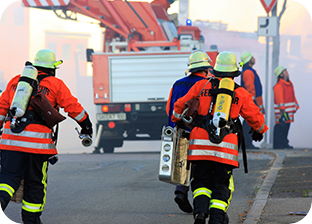OVERVIEW OF TRAINING MATERIAL
Start directly without any effort!

WORK SAFETY
In order to comply with the annual instruction obligation according to §12 of the German Occupational Health and Safety Act, this digital instruction was developed according to the requirements of the DGUV. The interactive guidance is accompanied by a speaker as well as hyperlinks to important sources and relevant documents that are integrated as PDFs in the program. In the section "Accident report", for example, not only is the obligation to document in audio and written form conveyed, but an accident report sheet is also made available with the module. Learn more
At the end of the instruction there is a multiple-choice test with which the employee can check his acquired knowledge. If 80% of the answers are correct, he is issued a certificate. The test can be repeated with different questions if the quota is low.
Legal basis
- Occupational Health and Safety Act, §12 Instruction “Obligates employers to instruct employees”
- DGUV (German Social Accident Insurance) Regulation 1, §4 Instruction of insured persons. “Regulates how entrepreneurs instruct their employees. At least 1 time per year. Instruction must be documented.”
- Technical rules for workplaces: ASR A1.3 “Guideline for safety and health signs.”
Topics in this instruction
Accident at work, occupational disease, commuting accident, behavior in the event of accidents, accident reporting, prevention: drugs and addictive substances; electrical equipment; tripping, falling, slipping; hazardous substances; company car, safety markings

FIRE PROTECTION
When was the last time you conducted fire safety training for all employees? Statistically, 2/3 of companies do not manage to train their staff sufficiently. With DigiDuck fire safety instruction, the lack of fire prevention training has come to an end. Learn more
At the end of the training there is a multiple-choice test with which the employee can check the knowledge he has acquired. If 80% of the answers are correct, he or she is issued a certificate. The test can be repeated with different questions if the quota is low.
Legal basis
- Occupational Health and Safety Act §10 First aid and other emergency measures “Requires employers to take measures necessary to fight fires”
- DGUV (German Social Accident Insurance) Regulation 1, §4 Instruction of insured persons. “Regulates how entrepreneurs instruct their employees. At least 1 time per year. Instruction must be documented.”
- Technical rules for workplaces: ASR A1.3 “Guideline for safety and health signs.”
- Technical rules for workplaces: ASR A2.2 “Guideline for measures against fires”
Topics in this instruction
Fire prevention, cause of fire, fire fighting, fire protection regulations, alarm and extinguishing systems, evacuation, fire protection in your company

FIRST AID
Despite all protective measures, occupational accidents involving employees cannot be completely ruled out. For this reason, the legislator obliges companies to provide "first aid" as mandatory instruction in the company to all employees. This must be in addition to the training of first aiders. Employees are trained in the most important basic rules in order to be able to initiate life-saving measures in the event of an emergency. In this instruction, your employees will learn how to react safely and correctly in emergencies with simple steps and what a rescue chain is, for example. Learn more
At the end of the instruction there is a multiple-choice test with which the employee can check his learned knowledge. If 80% of the answers are correct, he is issued a certificate. The test can be taken again with different questions if the quota is low.
Legal basis
- Occupational Health and Safety Act §10 First aid and other measures “Requires employers to take measures necessary to fight fires”
- DGUV (German Social Accident Insurance) Regulation 1, §4 Instruction of insured persons. “Regulates how entrepreneurs instruct their employees. At least 1 time per year. Instruction must be documented.”
- Technical rules for workplaces: ASR A1.3 “Guideline for safety and health signs”
- Penal Code § 323 C Failure to render assistance “Obligated to render first aid indirectly.”
Topics in this instruction
Rescue chain, immediate measures, further measures, rescue signs, first aid in your company

DATENSCHUTZ (Pflicht)
Die Rechtsgrundlagen des Datenschutzes sind von zentraler Bedeutung für jedes Unternehmen. Ein Verstoß gegen diese Vorschriften kann zu hohen Strafen führen und das Ansehen Ihres Unternehmens beeinträchtigen. Unternehmen sind gesetzlich dazu verpflichtet, ihre Mitarbeiterinnen und Mitarbeiter, die direkten oder indirekten Zugang zu personalisierten Daten haben, zum Thema Datenschutz zu unterweisen. Denn bei ihnen besteht ein hohes Risiko, gegen die Vorgaben der DSGVO und anderer Datenschutzvorschriften zu verstoßen. Insgesamt ist das E-Learning zum Thema Datenschutz ein wichtiger Bestandteil unseres Schulungsangebots. Durch diese Unterweisung werden Ihre Mitarbeiterinnen und Mitarbeiter sensibilisiert und informiert, was dazu beiträgt, dass sie die Vorschriften des Datenschutzes einhalten und somit Ihr Unternehmen und Ihre Kunden schützen. Learn more
Eine Pflicht, Mitarbeiterschulungen zum Datenschutz durchzuführen, lässt sich vor allem aus folgenden Vorgaben der DSGVO ableiten:
“Verantwortliche dürfen personenbezogene Daten ausschließlich auf rechtmäßige Weise, nach Treu und Glauben verarbeiten (Art. 5 Abs. 1 Buchstabe a DSGVO). Das ist nur möglich, wenn die Mitarbeiter wissen, wie und wann eine Verarbeitung rechtmäßig ist. Die Dokumentation, dass ein Unternehmen oder eine Behörde Datenschutzschulungen durchgeführt hat, erleichtert den Nachweis des Trainings im Rahmen der Rechenschaftspflicht (Art. 5 Abs. 2 DSGVO).”
“Verantwortliche dürfen nach DSGVO personenbezogene Daten nur verarbeiten, wenn technische und organisatorische Maßnahmen das Risiko von Datenschutzverstößen minimieren (Art. 32 DSGVO). Eine der organisatorischen Maßnahmen ist die Sensibilisierung und Schulung der Mitarbeiter zum Datenschutz. Aufgabe des Datenschutzbeauftragten ist es, die Sensibilisierung und Schulung der an den Verarbeitungsvorgängen beteiligten Mitarbeiter zu überwachen und zu überprüfen (Art. 39 Abs. 1 Buchstabe b DSGVO).”
Am Ende der Unterweisung gibt es einen Multiple-Choice-Test, mit dem der Mitarbeiter sein erlerntes Wissen überprüfen kann. Bei 80 % richtiger Antworten wird ihm ein Zertifikat ausgestellt. Der Test kann bei niedriger Quote mit abweichenden Fragen erneut durchgeführt werden.
Gesetzliche Grundlagen
- Arbeitsschutzgesetz, §12 Unterweisung „Verpflichtet Unternehmer die Mitarbeiter zu unterweisen“
- DGUV (Deutsche Gesetzliche Unfallversicherung) Vorschrift 1, §4 Unterweisung der Versicherten. „Regelt wie Unternehmer Ihre Mitarbeiter unterweisen. Mindestens 1-mal jährlich. Unterweisungen sind zu dokumentieren.“
- Technische Regeln für Arbeitsstätten: ASR A1.3 „Richtlinie für Sicherheits- und Gesundheitskennzeichen“
Themen in dieser Unterweisung
Rechtsgrundlagen, Grundsätze der Datenverarbeitung, Erlaubnisgründe, Betroffenenrechte, Datenpannen, Datenschutzverstöße, Datenschutzbeauftragte

DIENSTWAGEN (Pflicht)
Mit der Zunahme von Dienstwagen in Unternehmen aller Branchen und Größen ist auch der Bedarf an verbindlichen Regelungen rund um die Dienstwagennutzung gestiegen. Alle Fahrzeuge, die vom Arbeitgeber bereitgestellt und von den Beschäftigten bei der Arbeit benutzt werden, sind Arbeitsmittel im Sinne des §1 Abs. 1 der Betriebssicherheitsverordnung. Der Einsatz des Arbeitsmittels “Dienstwagen“ hat somit für den Arbeitgeber weitreichende Konsequenzen im Hinblick auf die von ihm zu beachtenden Arbeitsschutzvorschriften. Daraus ergibt sich unter anderem auch die jährliche Unterweisungspflicht seiner Beschäftigten nach §12 Arbeitsschutzgesetz. Learn more
Um dieser rechtskonform nachzukommen, wurde diese digitale Unterweisung nach den Anforderungen der DGUV entwickelt. Die interaktive Führung wird begleitet von einem Sprecher sowie Hyperlinks zu wichtigen Quellen und relevanten Dokumenten. Am Ende der Unterweisung gibt es einen Multiple-Choice-Test, mit dem der Mitarbeiter sein erlerntes Wissen überprüfen kann. Bei 80 % richtiger Antworten wird ihm ein Zertifikat ausgestellt. Der Test kann bei niedrigerer Quote mit abweichenden Fragen 2 mal durchgeführt werden, bevor die Schulung erneut durchgeführt werden muss.
Gesetzliche Grundlagen
- Arbeitsschutzgesetz, §12 Unterweisung „Verpflichtet Unternehmer die Mitarbeiter zu unterweisen“
- DGUV (Deutsche Gesetzliche Unfallversicherung) Vorschrift 1, §4 Unterweisung der Versicherten. „Regelt wie Unternehmer Ihre Mitarbeiter unterweisen. Mindestens 1-mal jährlich. Unterweisungen sind zu dokumentieren.“
- DGUV (Deutsche Gesetzliche Unfallversicherung) Vorschrift 70 – „Arbeitsmittel – Fahrzeuge, Arbeitsmaschinen, etc.“
- DGUV Grundsatz 314-002 „Kontrolle von Fahrzeugen durch Fahrpersonal“
- Straßenverkehrsordnung (StVO) und Straßenverkehrszulassungsordnung (StVZO)
Themen in dieser Unterweisung
Dokumentation, Sorgfaltspflichten; Kontrolle und Prüfung von Dienstfahrzeugen; Prävention: Fahrtvorbereitung, Sicheres Fahrverhalten, Erhaltung der Fahrtüchtigkeit, Arznei- und Suchtmittel; Verhalten bei Pannen & Unfällen; Haftung

ERGONOMICS FOR OFFICE WORKERS
In most cases, your office employees sit at their workstations for around 40 hours a week. During this activity, habits develop that can have a massive impact on the health of your employees. In this training we teach the correct way of sitting at the workplace, forms of dynamic work taking into account movement sequences and how to deal with any stress. Learn more
At the end of the instruction there is a multiple-choice test with which the employee can check his learned knowledge. If 80% of the answers are correct, he is issued a certificate. The test can be repeated with different questions if the quota is low.
Legal basis
- Occupational Health and Safety Act §3 Basic obligations of the employer “Improvement of safety and health protection of employees”
- DGUV (German Social Accident Insurance) Regulation 1, §4 Instruction of insured persons. “Regulates how employers instruct their employees. At least 1 time per year. Instruction must be documented.”
- Workplace Ordinance Annex Requirements and measures for workplaces according to § 3 paragraph 1 “The guidelines for the design of the workplace”
Topics in this instruction
Sitting correctly at a computer workstation, dynamic work (incorporating a lot of movement into the office routine), dealing with stress, as mental strain can be high.

ERGONOMICS FOR DRIVERS
40% of truck drivers suffer from back problems. Driving for hours on end in a truck means constant stress for the intervertebral discs. In this instruction we teach the correct sitting and perfect adjustment of the seat behind the steering wheel, the correct settings of the mirrors for posture and the correct stretching exercises during driver breaks. Learn more
At the end of the instruction, there is a multiple-choice test with which the employee can check his learned knowledge. If 80% of the answers are correct, he is issued a certificate. The test can be repeated with different questions if the quota is low.
Legal basis
- Occupational Health and Safety Act §3 Basic obligations of the employer “Improvement of safety and health protection of employees”
- DGUV (German Social Accident Insurance) Regulation 1, §4 Instruction of insured persons. “Regulates how employers instruct their employees. At least 1 time per year. Instruction must be documented.”
- Workplace Ordinance Annex Requirements and measures for workplaces according to § 3 paragraph 1 “The guidelines for the design of the workplace”
Topics in this instruction
Proper sitting behind the handlebars (adjust seat perfectly), correct mirror adjustments, clean windows and mirrors as part of ergonomics, proper movement (stretching exercises) during breaks in riding.

ERGONOMICS FOR WAREHOUSE WORKERS
Many warehouse employees are not aware of the lasting strain they place on their health and intervertebral discs. In this instruction, we impart the knowledge about the correct form of back-friendly lifting and carrying, climbing up and down loading platforms or even the correct ergonomic sitting on the forklift. Learn more
At the end of the instruction there is a multiple-choice test with which the employee can check his learned knowledge. If 80% of the answers are correct, he is issued a certificate. The test can be repeated with different questions if the quota is low.
Legal basis
- Occupational Health and Safety Act §3 Basic obligations of the employer “Improvement of safety and health protection of employees”
- DGUV (German Social Accident Insurance) Regulation 1, §4 Instruction of insured persons. “Regulates how employers instruct their employees. At least 1 time per year. Instruction must be documented.”
- Workplace Ordinance Annex Requirements and measures for workplaces according to § 3 paragraph 1 “The guidelines for the design of the workplace”
Topics in this instruction
Back-friendly lifting and carrying, mounting and dismounting from loading areas, correct seating in the forklift truck

PSA (PERSONAL PROTECTIVE EQUIPMENT)
The decision on the purchase of "personal protective equipment" (PPE) must be made as part of a risk assessment in accordance with the Occupational Health and Safety Act, the Ordinance on Industrial Safety and Health and the Ordinance on Hazardous Substances. For this, one proceeds according to the "TOP principle": Technical, organizational and personal measures. In this instruction, we will go into detail about the associated necessities in this regard. Learn more
At the end of the instruction there is a multiple-choice test with which the employee can check his learned knowledge. If 80% of the answers are correct, he is issued a certificate. The test can be repeated with different questions if the quota is low.
Legal basis
- Occupational Health and Safety Act §3 Basic obligations of the employer “Improvement of safety and health protection of employees”
- DGUV (German Social Accident Insurance) Regulation 1, §4 Instruction of insured persons. “Regulates how employers instruct their employees. At least 1 time per year. Instruction must be documented.”
- PPE user regulation “regulates the provision of personal protective equipment (PPE) by the employer and its use by employees.”
Topics in this instruction
General basics, PPE types at a glance: Skin protection, head protection, eye protection, hearing protection, respiratory protection, hand protection, foot protection, body protection

DIGITAL TACHOGRAPH
Commercial vehicles with a permissible total weight of more than 3.5 tons have been equipped with digital tachographs since 2006. Since the introduction of EU Regulation 165/2014, haulage companies have been responsible for ensuring that their drivers are adequately trained and can operate the digital tachograph correctly. With this training unit, you as an entrepreneur fulfill your obligation, the omission of which is subject to a fine. This training unit trains driving personnel in the use of VDO tachographs. Based on the regulations for driving and rest periods, we explain the proper use of the driver card and the menu navigation of the recording equipment. Learn more
At the end of the instruction there is a multiple-choice test with which the employee can check his learned knowledge. If 80% of the correct answers are achieved, he will be issued a certificate. The test can be repeated with different questions if the quota is low.
Legal basis
- Regulation (EU) No. 165/2014 OF THE EUROPEAN PARLIAMENT AND OF THE COUNCIL of February 4, 2014, Article 33 Responsibility of the transport operator
Topics in this instruction
Data acquisition, data history, types of cards, driver card, loss/theft/defect, operation of the recording equipment, types of equipment, release status, landing input, departure control, supplement, printout

DANGEROUS GOODS (ADR - ROAD) GENERAL CARGO TRANSPORT
In addition to occupational health and safety, those involved in the transport of dangerous goods must also be instructed at regular intervals (at the latest when the regulations change, usually in odd-numbered years). The hazardous goods regulations describe that no one may work in the hazardous goods area who does not have the required instruction. This applies both to the actual handling of dangerous goods as packers, loaders, unloaders, and to the groups of persons who prepare transport documents or transport orders. Learn more
In order to comply with the regular instruction obligation according to chapter 1.3 ADR, this digital instruction was developed.
The interactive guidance is accompanied by a speaker, hyperlinks to important sources and relevant documents, which are integrated as PDF in the program. At the end of the instruction there is a multiple-choice test with which the employee can check his acquired knowledge. If 80% of the answers are correct, he is issued a certificate. The test can be repeated with different questions if the quota is low.
Legal basis
- Dangerous Goods Ordinance Road Rail Inland Navigation (GGVSEB) §27 (5)
- ADR Chapter 1.3
Topics in this instruction
Identification of dangerous goods, classification, packaging, labeling, documents, equipment, duties in the transport chain, 1,000 point rule, Limited Quantity (LQ)

Gefahrgut 1.3 (ADR - Straße) Tank-Transport
Neben dem Arbeitsschutz müssen auch die Beteiligten am Gefahrguttransport in regelmäßigen Abständen (spätestens, wenn sich die Vorschriften ändern, in der Regel im ungeraden Jahr) unterwiesen werden. Die Gefahrgutvorschriften beschreiben, dass niemand im Gefahrgutbereich tätig sein darf, der nicht über eine erforderliche Unterweisung verfügt. Das gilt sowohl für den tatsächlichen Umgang mit dem Gefahrgut als Befüller, Entlader, als auch für die Personenkreise die Beförderungspapiere oder Transportaufträge erstellen. Learn more
Um der regelmäßigen Unterweisungspflicht nach Kapitel 1.3 ADR nachzukommen, wurde diese digitale Unterweisung entwickelt.
Die interaktive Führung wird begleitet von einem Sprecher, Hyperlinks zu wichtigen Quellen und relevanten Dokumenten, die als PDF im Programm integriert sind. Am Ende der Unterweisung gibt es einen Multiple-Choice-Test, mit dem der Mitarbeiter sein erlerntes Wissen überprüfen kann. Bei 80 % richtiger Antworten wird ihm ein Zertifikat ausgestellt. Der Test kann bei niedriger Quote mit abweichenden Fragen erneut durchgeführt werden.
Gesetzliche Grundlagen
- Gefahrgutverordnung Straße Eisenbahn Binnenschifffahrt (GGVSEB) §27 (5)
- ADR Kapitel 1.3
Themen in dieser Unterweisung
Identifikation von Gefahrgut, Klassifizierung, Tanks, Kennzeichnung, Dokumente, Ausrüstungsgegenstände, Pflichten in der Transportkette, Tunnelbeschränkungscode

FLURFÖRDERZEUGE
Flurförderzeuge sind vielseitig einsetzbare Transportgeräte, die von Unternehmen bereitgestellt und von den Beschäftigten bei der Ausübung ihrer Tätigkeit benutzt werden. Dazu gehören Gabelstapler und Hubwagen, die nach § 1 Abs. 1 der Betriebssicherheitsverordnung als Arbeitsmittel gelten. Der Einsatz von Flurförderzeugen hat somit für den Arbeitgeber weitreichende Konsequenzen hinsichtlich der einzuhaltenden Arbeitsschutzvorschriften. Darüber hinaus ergibt sich für den Arbeitgeber nach § 12 des Arbeitsschutzgesetzes die Pflicht zur jährlichen Unterweisung seiner Beschäftigten. Learn more
Um dieser rechtskonform nachzukommen, wurde diese digitale Folgeunterweisung nach den Anforderungen der DGUV entwickelt. Die interaktive Führung wird begleitet von einem Sprecher sowie Hyperlinks zu wichtigen Quellen und relevanten Dokumenten. Am Ende der Unterweisung gibt es einen Multiple-Choice-Test, mit dem der Mitarbeiter sein erlerntes Wissen überprüfen kann. Bei 80 % richtiger Antworten wird ihm ein Zertifikat ausgestellt. Der Test kann bei niedrigerer Quote mit abweichenden Fragen 2 mal durchgeführt werden, bevor die Schulung erneut durchgeführt werden muss.
Gesetzliche Grundlagen
- Arbeitsschutzgesetz, §12 Unterweisung „Verpflichtet Unternehmer die Mitarbeiter zu unterweisen“
- DGUV (Deutsche Gesetzliche Unfallversicherung) Vorschrift 1, §4 Unterweisung der Versicherten. „Regelt wie Unternehmer Ihre Mitarbeiter unterweisen. Mindestens 1-mal jährlich. Unterweisungen sind zu dokumentieren.“
- DGUV (Deutsche Gesetzliche Unfallversicherung) Vorschrift 70 – „Arbeitsmittel – Fahrzeuge, Arbeitsmaschinen, etc.“
- DGUV Vorschrift 68 „Flurförderzeuge“
Themen in dieser Unterweisung
Grundlagen, Anforderungen, Pflichten, Betrieb von FFZ, Umgang mit Last, Be- und Entladen von Fahrzeugen und von Regalen, Regelmäßige Prüfung, Unfallgeschehen,

ABFAHRTKONTROLLE
ABFAHRTKONTROLLE Im Güterverkehr muss jeder Straßentransport mit einer Abfahrtkontrolle beginnen. Bei unzureichender oder gar fehlender Durchführung drohen dem Fahrer und der Unternehmensleitung Sanktionen. Um dem Fahrpersonal das erforderliche Wissen zu vermitteln, haben wir die Unterweisung „Abfahrtkontrolle“ in drei verschiedenen Ausführungen entwickelt: • Stückgut • Schüttgut • Tank Learn more
Die Module behandeln detailliert alle Kontrollpunkte und gehen auf die Besonderheiten der jeweiligen Fahrzeuge ein. Mit unseren praxisrelevanten Tipps können die Abfahrtkontrollen zeiteffizient durchgeführt werden und mit der enthaltenen Checkliste bleibt kein Punkt mehr ungeprüft.
Die interaktive Führung wird begleitet von einem Sprecher sowie Hyperlinks zu wichtigen Quellen und relevanten Dokumenten. Am Ende der Unterweisung gibt es einen Multiple-Choice-Test, mit dem der Mitarbeiter sein erlerntes Wissen überprüfen kann. Bei 80 % richtiger Antworten wird ihm ein Zertifikat ausgestellt. Der Test kann bei niedrigerer Quote mit abweichenden Fragen 2-mal durchgeführt werden, bevor die Schulung erneut durchgeführt werden muss.
Gesetzliche Grundlagen
- Arbeitsschutzgesetz, §12 Unterweisung „Verpflichtet Unternehmer die Mitarbeiter zu unterweisen“
- DGUV (Deutsche Gesetzliche Unfallversicherung) Vorschrift 1, §4 Unterweisung der Versicherten. „Regelt wie Unternehmer Ihre Mitarbeiter unterweisen. Mindestens 1-mal jährlich. Unterweisungen sind zu dokumentieren.“
- DGUV (Deutsche Gesetzliche Unfallversicherung) Vorschrift 70 – Fahrzeuge
- StVo / StVZO
- HGB
- DIN EN 12195-1 / VDI 2700
- ADR / GGVSEB
Themen in dieser Unterweisung
Rechtsgrundlagen, Gesetze, Vorschriften, Richtlinien, Verantwortlichkeiten, Dokumentation, Prüfpunkte, Vorgaben, Hilfsmittel, Tipps, Checklisten, VorGEHENsweisen, Besonderheiten

HACCP für Lager- & Fahrpersonal
Das in der Lebensmittelproduktion tätige Personal muss über die Grundlagen von HACCP informiert und entsprechend geschult werden. HACCP ist nicht nur eine wichtige Sicherheitsmaßnahme, sondern auch gesetzlich vorgeschrieben. Mit dieser Unterweisung können Mitarbeiter sensibilisiert werden, um Gefahren frühzeitig zu erkennen und Schutzmaßnahmen einzuleiten. Learn more
Unsere digitale HACCP-Schulung wurde gemäß den Anforderungen der DGUV entwickelt und bietet eine interaktive Führung durch das Thema. Ein Sprecher begleitet die Schulung und es gibt Hyperlinks zu wichtigen Quellen und Dokumenten. Am Ende der Schulung gibt es einen Multiple-Choice-Test, um das erlernte Wissen zu überprüfen. Bei 80 % richtiger Antworten wird ein Zertifikat ausgestellt. Der Test kann bei niedrigerer Quote mit abweichenden Fragen 2-mal durchgeführt werden, bevor die Schulung erneut absolviert werden muss.
Gesetzliche Grundlagen
• (Lebensmittel)Basisverordnung
• Hygieneverordnung
Themen in dieser Unterweisung
Bedeutung von HACCP, Begriffe, Identifikation von Gefahren, Vermeidung von Gefahren, Dokumentation, Verantwortlichkeiten, Mitwirkungspflichten
Further training courses and instructions are already being implemented: dangerous goods according to ADR 1.3 Tank, load securing, departure control, data protection, HACCP, lithium batteries, ladders and steps, noise, skin protection, use of company cars, industrial trucks, and much more.
Please inquire.